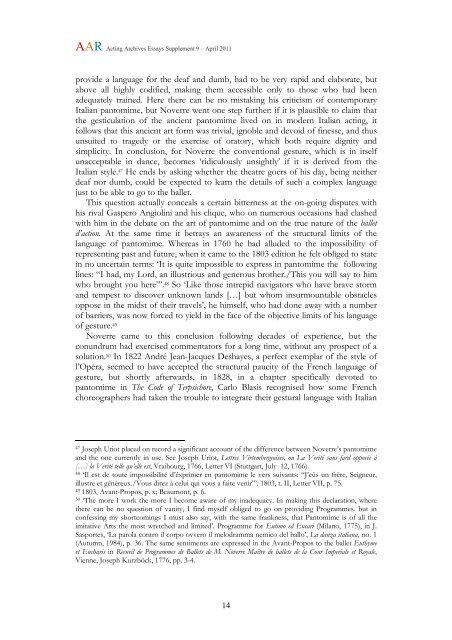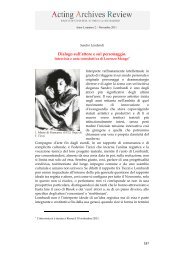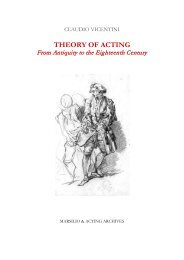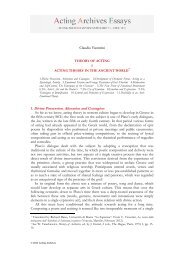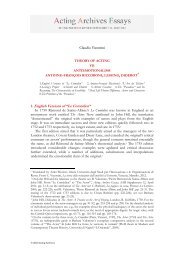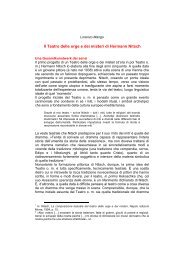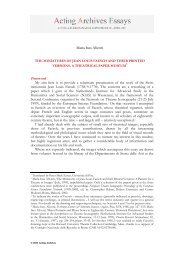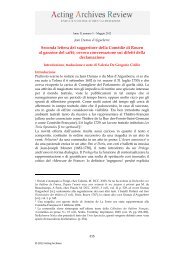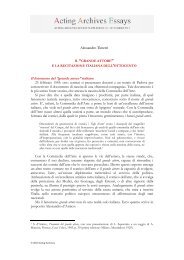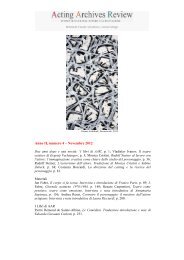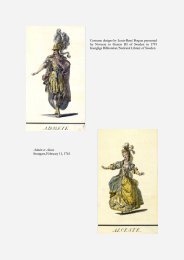Flavia Pappacena_Noverre's Lettres sur la Danse - Acting Archives
Flavia Pappacena_Noverre's Lettres sur la Danse - Acting Archives
Flavia Pappacena_Noverre's Lettres sur la Danse - Acting Archives
You also want an ePaper? Increase the reach of your titles
YUMPU automatically turns print PDFs into web optimized ePapers that Google loves.
AAR <strong>Acting</strong> <strong>Archives</strong> Essays Supplement 9 – April 2011<br />
provide a <strong>la</strong>nguage for the deaf and dumb, had to be very rapid and e<strong>la</strong>borate, but<br />
above all highly codified, making them accessible only to those who had been<br />
adequately trained. Here there can be no mistaking his criticism of contemporary<br />
Italian pantomime, but Noverre went one step further: if it is p<strong>la</strong>usible to c<strong>la</strong>im that<br />
the gesticu<strong>la</strong>tion of the ancient pantomime lived on in modern Italian acting, it<br />
follows that this ancient art form was trivial, ignoble and devoid of finesse, and thus<br />
unsuited to tragedy or the exercise of oratory, which both require dignity and<br />
simplicity. In conclusion, for Noverre the conventional gesture, which is in itself<br />
unacceptable in dance, becomes ‘ridiculously unsightly’ if it is derived from the<br />
Italian style. 47 He ends by asking whether the theatre goers of his day, being neither<br />
deaf nor dumb, could be expected to learn the details of such a complex <strong>la</strong>nguage<br />
just to be able to go to the ballet.<br />
This question actually conceals a certain bitterness at the on-going disputes with<br />
his rival Gaspero Angiolini and his clique, who on numerous occasions had c<strong>la</strong>shed<br />
with him in the debate on the art of pantomime and on the true nature of the ballet<br />
d’action. At the same time it betrays an awareness of the structural limits of the<br />
<strong>la</strong>nguage of pantomime. Whereas in 1760 he had alluded to the impossibility of<br />
representing past and future, when it came to the 1803 edition he felt obliged to state<br />
in no uncertain terms: ‘It is quite impossible to express in pantomime the following<br />
lines: “I had, my Lord, an illustrious and generous brother./This you will say to him<br />
who brought you here”’. 48 So ‘Like those intrepid navigators who have brave storm<br />
and tempest to discover unknown <strong>la</strong>nds […] but whom in<strong>sur</strong>mountable obstacles<br />
oppose in the midst of their travels’, he himself, who had done away with a number<br />
of barriers, was now forced to yield in the face of the objective limits of his <strong>la</strong>nguage<br />
of gesture. 49<br />
Noverre came to this conclusion following decades of experience, but the<br />
conundrum had exercised commentators for a long time, without any prospect of a<br />
solution. 50 In 1822 André Jean-Jacques Deshayes, a perfect exemp<strong>la</strong>r of the style of<br />
l’Opéra, seemed to have accepted the structural paucity of the French <strong>la</strong>nguage of<br />
gesture, but shortly afterwards, in 1828, in a chapter specifically devoted to<br />
pantomime in The Code of Terpsichore, Carlo B<strong>la</strong>sis recognised how some French<br />
choreographers had taken the trouble to integrate their gestural <strong>la</strong>nguage with Italian<br />
47 Joseph Uriot p<strong>la</strong>ced on record a significant account of the difference between Noverre’s pantomime<br />
and the one currently in use. See Joseph Uriot, <strong>Lettres</strong> Virtembergeoises, ou La Verité sans fard opposée à<br />
[…] <strong>la</strong> Verité telle qu’elle est, Vraibourg, 1766, Letter VI (Stuttgart, July 12, 1766).<br />
48 ‘Il est de toute impossibilité d’éxprimer en pantomime le vers suivants: “J’eûs un frère, Seigneur,<br />
illustre et généreux./Vous direz à celui qui vous a faite venir”’. 1803, t. II, Letter VII, p. 75.<br />
49 1803, Avant-Propos, p. x; Beaumont, p. 6.<br />
50 ‘The more I work the more I become aware of my inadequacy. In making this dec<strong>la</strong>ration, where<br />
there can be no question of vanity, I find myself obliged to go on providing Programmes. but in<br />
confessing my shortcomings I must also say, with the same frankness, that Pantomime is of all the<br />
imitative Arts the most wretched and limited’. Programme for Eutimo ed Eucari (Mi<strong>la</strong>no, 1775), in J.<br />
Sasportes, ‘La paro<strong>la</strong> contro il corpo ovvero il melodramma nemico del ballo’, La danza italiana, no. 1<br />
(Autumn, 1984), p. 36. The same sentiments are expressed in the Avant-Propos to the ballet Euthyme<br />
et Eucharis in Recueil de Programmes de Ballets de M. Noverre Maître de ballets de <strong>la</strong> Cour Imperiale et Royale,<br />
Vienne, Joseph Kurzböck, 1776, pp. 3-4.<br />
14


